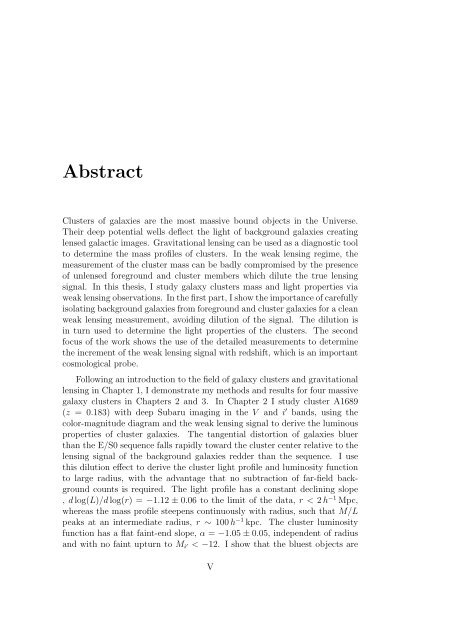Mass and Light distributions in Clusters of Galaxies - Henry A ...
Mass and Light distributions in Clusters of Galaxies - Henry A ...
Mass and Light distributions in Clusters of Galaxies - Henry A ...
Create successful ePaper yourself
Turn your PDF publications into a flip-book with our unique Google optimized e-Paper software.
Abstract<br />
<strong>Clusters</strong> <strong>of</strong> galaxies are the most massive bound objects <strong>in</strong> the Universe.<br />
Their deep potential wells deflect the light <strong>of</strong> background galaxies creat<strong>in</strong>g<br />
lensed galactic images. Gravitational lens<strong>in</strong>g can be used as a diagnostic tool<br />
to determ<strong>in</strong>e the mass pr<strong>of</strong>iles <strong>of</strong> clusters. In the weak lens<strong>in</strong>g regime, the<br />
measurement <strong>of</strong> the cluster mass can be badly compromised by the presence<br />
<strong>of</strong> unlensed foreground <strong>and</strong> cluster members which dilute the true lens<strong>in</strong>g<br />
signal. In this thesis, I study galaxy clusters mass <strong>and</strong> light properties via<br />
weak lens<strong>in</strong>g observations. In the first part, I show the importance <strong>of</strong> carefully<br />
isolat<strong>in</strong>g background galaxies from foreground <strong>and</strong> cluster galaxies for a clean<br />
weak lens<strong>in</strong>g measurement, avoid<strong>in</strong>g dilution <strong>of</strong> the signal. The dilution is<br />
<strong>in</strong> turn used to determ<strong>in</strong>e the light properties <strong>of</strong> the clusters. The second<br />
focus <strong>of</strong> the work shows the use <strong>of</strong> the detailed measurements to determ<strong>in</strong>e<br />
the <strong>in</strong>crement <strong>of</strong> the weak lens<strong>in</strong>g signal with redshift, which is an important<br />
cosmological probe.<br />
Follow<strong>in</strong>g an <strong>in</strong>troduction to the field <strong>of</strong> galaxy clusters <strong>and</strong> gravitational<br />
lens<strong>in</strong>g <strong>in</strong> Chapter 1, I demonstrate my methods <strong>and</strong> results for four massive<br />
galaxy clusters <strong>in</strong> Chapters 2 <strong>and</strong> 3. In Chapter 2 I study cluster A1689<br />
(z = 0.183) with deep Subaru imag<strong>in</strong>g <strong>in</strong> the V <strong>and</strong> i ′ b<strong>and</strong>s, us<strong>in</strong>g the<br />
color-magnitude diagram <strong>and</strong> the weak lens<strong>in</strong>g signal to derive the lum<strong>in</strong>ous<br />
properties <strong>of</strong> cluster galaxies. The tangential distortion <strong>of</strong> galaxies bluer<br />
than the E/S0 sequence falls rapidly toward the cluster center relative to the<br />
lens<strong>in</strong>g signal <strong>of</strong> the background galaxies redder than the sequence. I use<br />
this dilution effect to derive the cluster light pr<strong>of</strong>ile <strong>and</strong> lum<strong>in</strong>osity function<br />
to large radius, with the advantage that no subtraction <strong>of</strong> far-field background<br />
counts is required. The light pr<strong>of</strong>ile has a constant decl<strong>in</strong><strong>in</strong>g slope<br />
, d log(L)/d log(r) = −1.12 ± 0.06 to the limit <strong>of</strong> the data, r < 2 h −1 Mpc,<br />
whereas the mass pr<strong>of</strong>ile steepens cont<strong>in</strong>uously with radius, such that M/L<br />
peaks at an <strong>in</strong>termediate radius, r ∼ 100 h −1 kpc. The cluster lum<strong>in</strong>osity<br />
function has a flat fa<strong>in</strong>t-end slope, α = −1.05 ± 0.05, <strong>in</strong>dependent <strong>of</strong> radius<br />
<strong>and</strong> with no fa<strong>in</strong>t upturn to M i ′ < −12. I show that the bluest objects are<br />
V
















